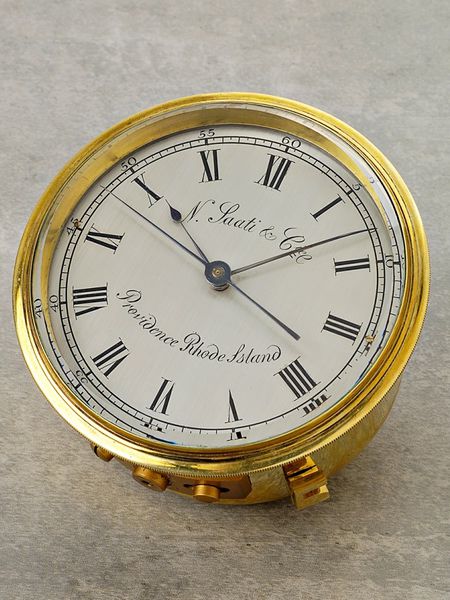Datei:N. Saati & Cie., Providence, Rhode Island, circa 1895 (2).jpg

Originaldatei (664 × 885 Pixel, Dateigröße: 253 KB, MIME-Typ: image/jpeg)
N. Saati & Cie., Providence, Rhode Island, 125 mm, circa 1895

|
Alle Bildrechte liegen bei Auktionen Dr. H. Crott. Diese Abbildung ist urheberrechtlich geschützt und steht nicht unter einer freien Lizenz. Für anderweitige Nutzungen außerhalb von Watch-Wiki ist die schriftliche Zustimmung des Urheberrechtsinhabers nötig. |
Einzigartiges Schiffschronometer mit räderlosem Werk über Schneckenwellenantrieb nach dem deutschen Patent Nr. 81824 vom 9. Januar 1894 Geh.: Palisander. Ziffbl.: versilbert. Werk: Messingwerk, Ankerhemmung, bimetallische Chronometerunruh mit 2 Gewichten und 4 Schrauben.
A unique ship's chronometer with worm gear movement according the German patent No. 81824 from Januar 9 1894 Case: palisander. Dial: silvered. Movm.: brass movement, lever escapement, bimetallic chronometer balance with 2 weights and 4 screws.
The chronometer by Nowman Micah Saati was an attempt (that was even patented) to replace the normal train of a watch by a mechanism where the large escapement wheel was driven by a worm gear. The construction was intended to improve performance with a simplified mechanism; the latter, however, is doubtful, as a constant transmission of power from the barrel onto the fusee (or the worm gear) was imperative. The attempt resulted in this construction that essentially corresponds to the patent design: two leverage systems alternately act on the gear wheel on the barrel. The force is diverted in the mounting and used to push a second lever in the spiral upward. When the free lever is caught by the gearing of the barrel, the active part is release and falls downward – it is the part under spring tension that now drives the movement. In another intricate detail the leverage systems as a whole are subject to lateral adjustment, thus avoiding the barrel teeth. The operating noise is unusual in that the usual ticking of a marine chronometer is interspersed by a loud ticktack sound when the levers change. The mechanism was not really a striking success. We know of another chronometer that uses it, which, however, seems to be a kind of prototype. Saati was not the only one who tried to fit movements with worm gears: Hans-F. Tölke described that in an amusing article in issues 5 and 6 of "Klassik Uhren" of 1994 and also mentions Saati’s patent.
Dateiversionen
Klicke auf einen Zeitpunkt, um diese Version zu laden.
| Version vom | Vorschaubild | Maße | Benutzer | Kommentar | |
|---|---|---|---|---|---|
| aktuell | 19:59, 18. Okt. 2016 |  | 664 × 885 (253 KB) | Andriessen (Diskussion | Beiträge) | N. Saati & Cie., Providence, Rhode Island, 125 mm, circa 1895 {{Bildrechte U|Auktionen Dr. H. Crott}} Einzigartiges Schiffschronometer mit räderlosem Werk über Schneckenwellenantrieb nach dem deutschen Patent Nr. 81824 vom 9. Januar 1894 Geh.: P… |
Du kannst diese Datei nicht überschreiben.
Dateiverwendung
Keine Seiten verwenden diese Datei.
- Bildgalerie Uhrenmodelle Saati, Nowman Micah
- Picture gallery watch models Saati, Nowman Micah
- Galería de imagenes de modelos de relojes Saati, Nowman Micah
- Afbeeldingen galerij uurwerkmodellen Saati, Nowman Micah
- Фотогалерея Модели часов Saati, Nowman Micah
- Galleria fotografica di modelli orologi Saati, Nowman Micah